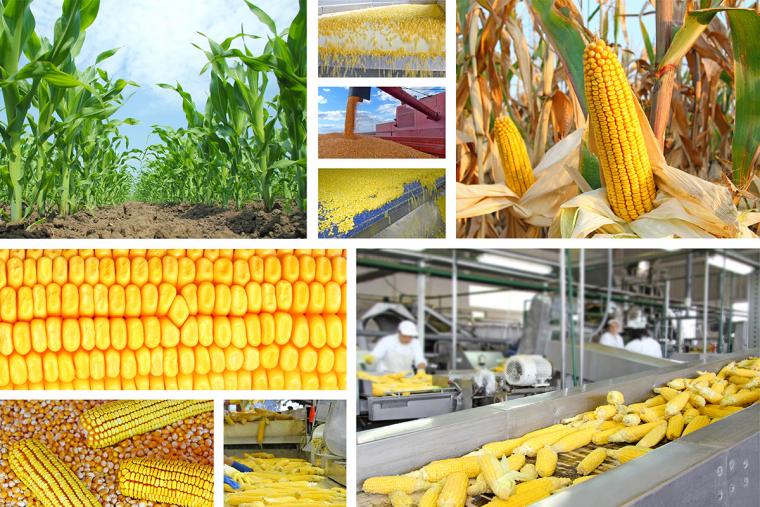
 In an ever-evolving industry, food manufacturing companies constantly juggle cost control with the technology, standards and innovation that are required to command the trust of the consumer. Changing consumer tastes, commodity price swings, food safety standards, an increasingly stringent regulatory environment and speed to market demands—to name just a few—all impact the sensitive food manufacturing segment of the economy.
In an ever-evolving industry, food manufacturing companies constantly juggle cost control with the technology, standards and innovation that are required to command the trust of the consumer. Changing consumer tastes, commodity price swings, food safety standards, an increasingly stringent regulatory environment and speed to market demands—to name just a few—all impact the sensitive food manufacturing segment of the economy.
So, when it comes to a food company’s site selection decisions, executives know that proper location can dramatically impact a wide array of operational and cost-related variables, going well beyond initial costs for real estate. When you consider the total business operation, real estate itself may be a relatively small piece of the equation, but it can have a tremendous impact on the cost to produce and deliver product to market. For a food manufacturer, the site selection process will play a critical role in setting into motion a company’s long-term success and profitability.
As real estate professionals dedicated to serving the industrial food sector, we work with food companies throughout their full business life cycles. Whether a company is just starting out, is in its growth stage, or has matured, if it’s contemplating new construction or the utilization of a second-generation food facility, it’s crucial to analyze the numerous factors and impacts a location decision will have on the company’s business.
Neither construction cost, purchase price, lease rate or the lure of a highly improved, usable building should singlehandedly lead the decision process or overshadow other business concerns. Sometimes, an existing food plant can align quite effectively with a company’s operations and growth trajectory.

One trend we’re seeing are more adaptive builds or modifications of existing facilities, and a bit less “ground up” food plant development. For various reasons, including cost savings and time advantages, larger companies are more willing to look at second-generation facilities or building-out existing food production plants (often in temperature-controlled food distribution centers).
When it comes to site selection, often our job is to work backwards from the real estate to understand how the decision will impact the future of the business. Alternatively, in a more traditional site selection process, we may begin by understanding and evaluating a company’s business needs and determining the most complementary geographies to the objectives.
But, regardless of whether we work “backwards” or “forwards,” it’s imperative to anticipate the long-term impact of a food plant location decision. Food manufacturing operations require high levels of infrastructure and improvements and are hardly mobile. An ill-conceived decision can be costly.
Evaluating Facility Use and Reuse
When we’ve worked with food companies that may be in the “decline” phase of their businesses, our team sees where and why operations have fallen short of business objectives. Often, reasons run the gamut—from supply chain redundancies, to contraction of product/sector demand, to inadequate labor, to unavailable raw goods resources, to recalls and more. Issues such as droughts and herd depletion can also destroy the viability of an operation for a specific food use.
 As we evaluate reuse of a shuttered food facility, we examine compatible food uses, understanding that the demands of each food operation are unique. What is inadequate, redundant or even obsolete for one food manufacturer may work well for the demands of another operation, depending on variables such as product type, available resources, temperature requirements, head count, facility certifications and location within the company’s greater operating network. For example, a facility may fail to offer enough water or wastewater capacity for one operation, but it may be more than suitable for another food manufacturing use that requires less water for production.
As we evaluate reuse of a shuttered food facility, we examine compatible food uses, understanding that the demands of each food operation are unique. What is inadequate, redundant or even obsolete for one food manufacturer may work well for the demands of another operation, depending on variables such as product type, available resources, temperature requirements, head count, facility certifications and location within the company’s greater operating network. For example, a facility may fail to offer enough water or wastewater capacity for one operation, but it may be more than suitable for another food manufacturing use that requires less water for production.
For food companies in the growth and maturity phase, the site selection process has the potential to be long, complex and capital-intensive. For large companies, the full process is usually scalable. For smaller companies, however, the feasibility and reality of undergoing an all-encompassing site selection process can vary, based on company size and requirements.
Size, scale and capital allow large-cap food companies to be more strategic in their long-term growth plans. For companies of this size, it is common to plan a project several years in advance of occupancy, in anticipation of future growth. The process begins as a food business plans operational shifts to be closer to end users, enhance access to suppliers, expand market share or perhaps expand product offerings. Depending on the sophistication of the internal business units and external resources employed, the process can be complex but coordinated.
 Starting the Real Estate ‘Process’
Starting the Real Estate ‘Process’
The real estate “process” begins well before the real estate itself. In the most efficient scenarios, we’re engaged early in the process, working from project inception with our supply chain, labor, incentives and project management experts to define objectives that span many company dimensions.
When executed properly, supply chain is the leading factor. Logistics studies and analysis serve as the preliminary process framework to define the target geographic region. In doing so, we’re able to minimize transportation costs and routing redundancies, while maximizing proximity to growers and raw goods, improving speed to market of perishables, and optimizing weather and topography concerns.
At the same time, our labor experts narrow the geographic focus by analyzing factors such as cost, availability, scalability, projected wage growth and attrition rates to forecast a food company’s operational viability in target communities. Considerations such as competing industries and wages, existing skillsets and a community’s ability to grow with the company are imperative to success.
Working hand in hand with the labor team, our economic incentives consultants analyze incentive offerings on local, county and state levels. As the findings of the three areas of study converge, only then does the physical real estate start to come into play.
 Site Evaluation for New Construction
Site Evaluation for New Construction
After analyzing all these factors and provided there is ample time, for a company seeking a state-of-the-art operation, new construction is often the solution, since existing large, industry-leading food manufacturing plants rarely become available. At this point, the focus will shift to site evaluation, acquisition and construction.
In the site evaluation process, we work with our project management team to analyze factors such as utility infrastructure (and any necessary upgrades). The project managers evaluate contractors, architects and design-build engineers and run a coordinated process aimed at cost control, risk mitigation and quality preservation.
At the same time, the negotiation process continues with economic development. As the project scope becomes clearly defined, we seek above statutory incentives, which may include rebates, cash grants, job training, impact fee assistance, infrastructure and utility improvements, as well as assistance in structuring competitive supplier contracts.
For smaller food companies, the real estate process often is less formulaic. Rather than adding or relocating one of many dots on the supply chain map, as in the case of a large food company, the magnitude of new real estate projects can be great. A small or mid-cap company can sometimes double or even triple market share as the result of a new project—these projects are high-risk, high-reward.
Despite the criticality of these decisions, high-growth food companies that are transitioning from local to regional, or regional to national, often find themselves building processes and structure midstream. Unlike a large-cap company’s chronological process, the site selection playbook for smaller food companies often is written while the process is under way. The companies may begin discussion of important issues late in the process, and timeline can usurp the process as they scramble to achieve the scale required by new customers and contracts. Sometimes important concerns regarding long-term viability surface even after a plant has been completed.
 Define a Realistic Project Scope
Define a Realistic Project Scope
Typically, project lead times for small and mid-cap companies are six to 12 months. When a new, mega-customer contract comes to fruition, the clock begins ticking. Other project accelerators may include dramatic shifts in the market or private equity-backed growth initiatives. In these cases, we begin by defining a realistic project scope, which usually precludes new construction due to time constraints. Total project time for site selection, incentives, due diligence, permitting and infrastructure enhancement, design, construction and equipment installation can be unrealistic or require too many compromises for on-time delivery.
As food companies begin to examine the market for “second-generation” food plants, they can make the mistake of letting the real estate drive the business decision. Companies tend to forgo deeper location analysis, settling for regional geography deemed suitable. The cost of new construction can be many times the cost to acquire a second-generation food plant. But keep in mind, the cost of a second-generation facility increases when contemplating required upgrades and modifications—however, it is still usually much less expensive than the new construction alternative when the facility has a compatible former use and layout.
Nevertheless, the relative ease and cost savings from acquiring a second-generation food plant must be examined under the lens of supply chain and labor, both of which significantly outweigh real estate costs. At this point, the company must “work backwards” to ensure that the location is not a short-term win and a long-term disaster.
The real estate process for a food company of any size is not one size fits all. While smaller companies cannot typically afford the luxury of new construction, they can still be strategic with their processes as they compare second-generation food plants to the alternative of retrofitting generic industrial buildings. An existing food facility’s high level of improvements, including the refrigeration system, utility infrastructure, process-specific configuration and existing processing equipment, can provide substantial incentive for a company to avoid major capital outlay and achieve speed to market.
If the geography is suitable but not optimal, economic incentives can sweeten the deal. Alternatively, a great location paired with an aggressive economic development community can provide a compelling retrofit opportunity.
As consumers and customers continue to demand increasing levels of excellence and sophistication of their suppliers, food manufacturers must also evolve their site selection processes in order to stay competitive in an environment where the label “state-of-the-art” expires quickly.
No longer is a regimented, strategic site selection process unique to food industry household names. Small and mid-cap companies are increasingly analyzing the greater business impacts of their real estate decisions. By studying location impacts alongside analysis of existing food grade improvements, a food company of any size can position its new plant competitively. T&ID
Business is Booming in Pike County, Ala.
When it comes to food and manufacturing, Pike County, Ala., is making things happen. Recently, Conecuh Ridge Distillery, makers of Clyde May’s Alabama-style whiskey, announced plans to consolidate operations in Troy, where the company will build an artisan distillery, rack houses and a bottling hub, as well as a tasting experience center designed to attract tourists. Initial investment will be $13.6 million, and the project is expected to employ 50 people over the next few years.
Troy is also home to Golden Boy Foods, a leading manufacturer, marketer and distributor of private label peanut butter and branded food products.
In addition, Wickles Pickles, maker of all types of pickles, relishes and spreads, is moving its production from North Carolina back to Alabama in a new facility in Brundidge.
To further whet the appetite for business, Rex Lumber Co. is building a state-of-the-art lumber manufacturing facility in Pike County, creating more than 110 jobs and providing a significant economic boost to the region’s forest products industry. Total capital investment of the new sawmill is projected to be $110 million.
For more information, visit www.troy-pike-edc.org.
A Commitment to Quality in Thomasville, Ga.
Imagine Thomasville is tasked with generating millions of dollars per year in jobs (or “payroll”) for the community. While this may seem like a daunting task for a rural area, it is amazing to see the industries that call this Georgia region home.
Companies such as the Flowers Baking Company and Flowers Foods headquarters, FPL Foods and AgPro’s corporate offices are located here. Working alongside these titans are grassroots innovators like Sweetgrass Dairy and Blackberry Patch, which have grown a national reach right from their family farms and small factories.
No matter how large or small, communities succeed when they are willing to innovate. And a community’s strength—whether it comes from agriculture, food or manufacturing—can be found in its values. All of these are key elements with Imagine Thomasville.
The common ground is a commitment to quality products, a great lifestyle and a strong workforce—all of which are found in abundance in the Thomasville area.
For more information about Thomasville and Thomas County, visit www.developthomas.com.


